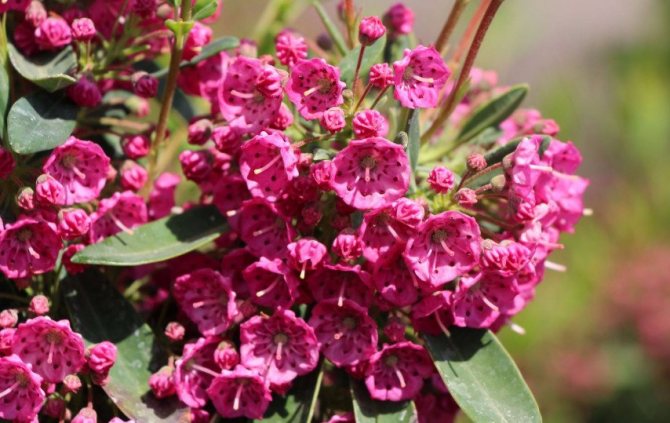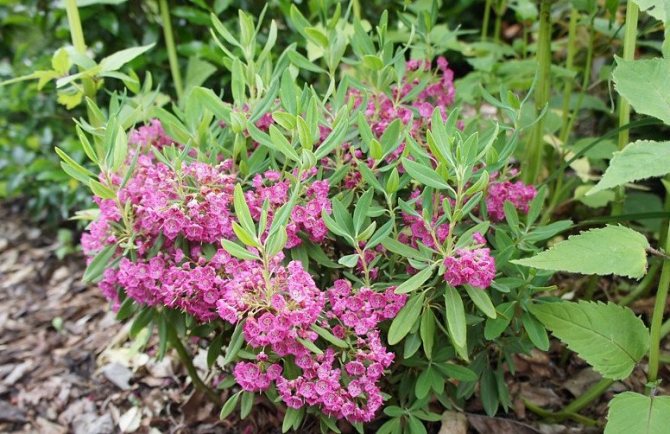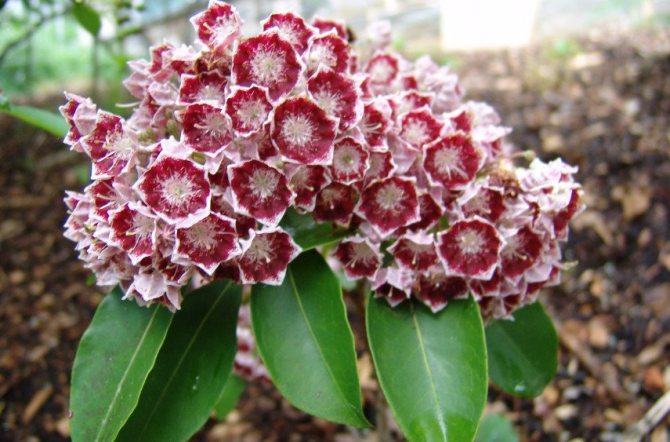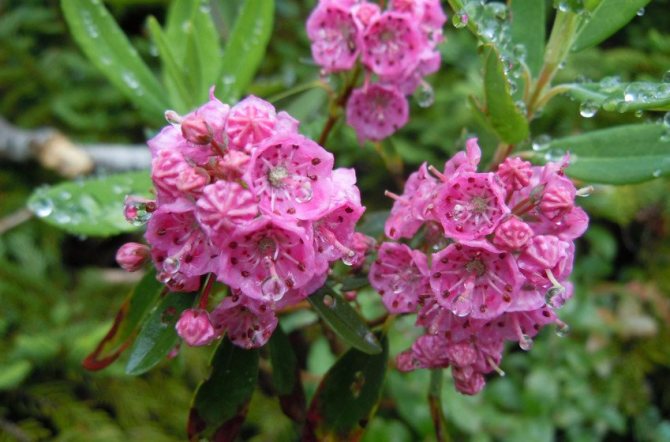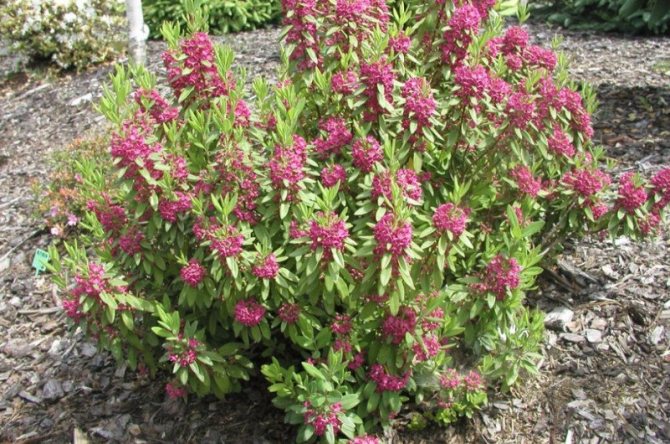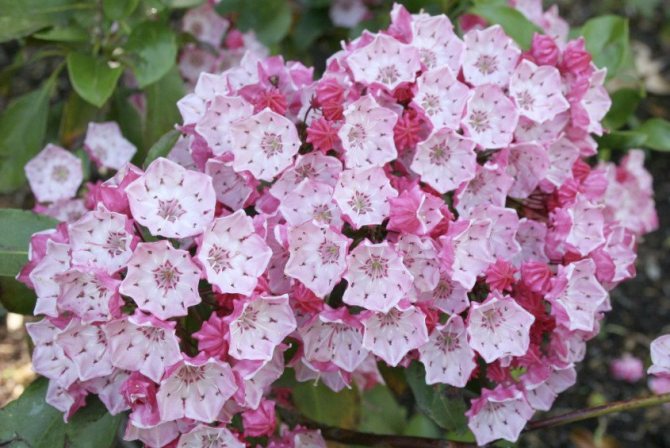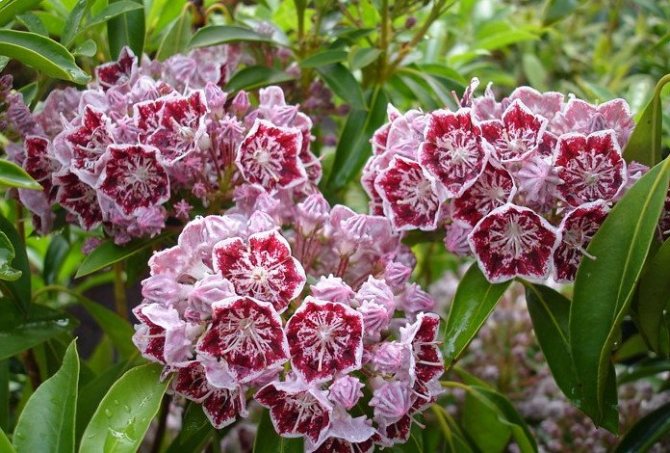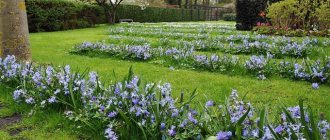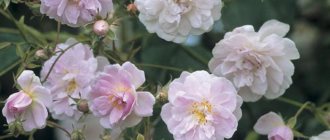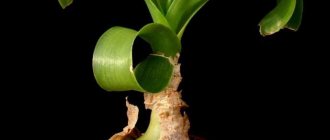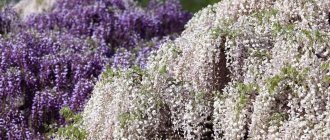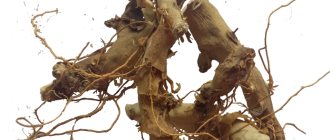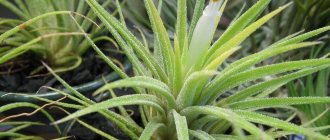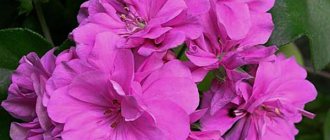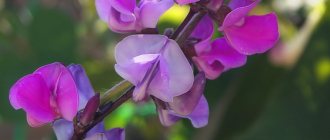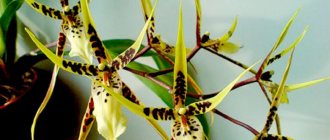- Description, types and varieties
- Planting Calmia
- Plant care
- Features of growing calcium
- Plant propagation
- Calmia: video
Broadleaf Kalmia: photo, varieties, cultivation and care. Broad-leaved Kalmia, like its other varieties, can become an adornment of any suburban area. It is decorative all year round both in single plantings and in compositions with other plants, but it is especially good in spring, when it is covered with a lush cloud of delicate flowers. In our country, this ornamental shrub is not found everywhere. And the reason for this is some difficulties in its cultivation and care.
Short description
You can endlessly admire the refined, exquisite beauty of this plant. Its decorative characteristics are second only to rhododendrons. It is not for nothing that many sources describe this type of kalmias as one of the most beautiful.
Did you know? The name was given to the flower in honor of the Swedish botanist Pierre Calm, who, back in the 17th century, made the first attempts to grow wild tree-like shrubs from North America in European lands.

Externally, broad-leaved kalmia (kalmia latifolia) is an evergreen shrub with lignified central stems up to 9 m high, wide, hard lanceolate foliage and lush umbellate inflorescences consisting of 250 single flowers.
In the wild North American rocky terrain and mountain forests, which are their native habitat, the plant is impressive in size and often reaches a height of 12-15 m. It is impossible to grow such a giant at home.
Buddleya David, heather, hydrangea, weigela, jasmine, cinquefoil, camellia, magnolia, lilac, spiraea, forsythia are shrubs that will perfectly decorate your garden plot.
The culture develops slowly, growing about 2 cm of branches annually. At the first stages of development, they are thin, but elastic, with a purple bark, and with aging they become gray-brown and lignified.
The leaf plates are characterized by a dark green color on the outside and a light color on the inside. The dimensions of each leaf are from 7 to 12 cm in length, and up to 4 cm in width.
The shrub blooms in late spring. Its dense flower clusters are located on the tops of the shoots and, when the buds open, completely cover the crown with delicate petals. A fabulous atmosphere reigns in the garden for a month, until the flowers fall.


Important! The composition of kalmiya contains toxic substances - andromethoxin and albutin, which, when in contact with the mucous membranes of living organisms, cause severe irritation, vomiting, respiratory problems, convulsions, paralysis, and slow the heartbeat. As a result of such contact, a person or animal can die. Therefore, when working with shrubs, observe safety measures and try not to touch the stems, leaves and flowers.
Initially, only scarlet broad-leaved kalmiya existed in nature, but breeders managed to significantly expand the color gamut of the plant, and also pleasantly surprise flower growers with varieties with intricate ornaments and borders on the petals.
Small-leaved Kalmia
Small-leaved Kalmia (Kalmia microphylla) is widely known to the inhabitants of the western States of America and central Canada, where it comes from.Its evergreen shrubs in the wild spread far to the North, up to the Arctic Circle. They can be found on heather steppes, where acidic moist soils.
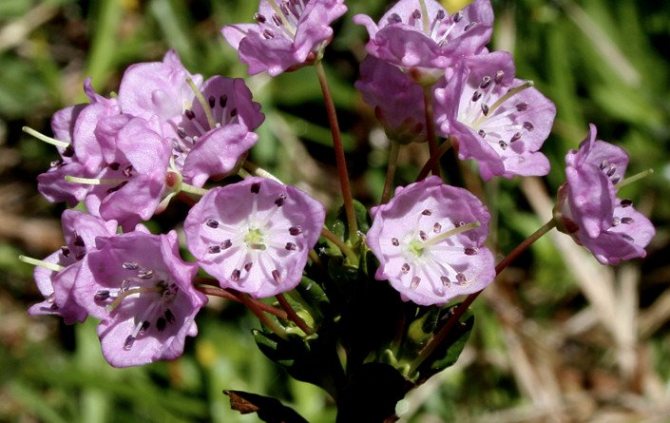

Important! Most varieties of kalmias react very painfully to direct sunlight in winter and spring.
Outwardly, it is a medium-sized shrub with stems up to 2 m in height, strong spreading branches, which at the beginning of development are green and heavily pubescent, and when they mature, they become smooth and brown. The foliage on the plant is tough, lanceolate, with curled ends.
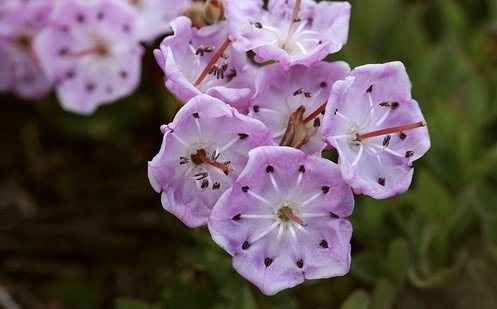

Small-leaved salsa is easy to confuse with multifoliate. You can distinguish the first species from the second by the pink and crimson grape-like brushes, which consist of flowers resembling bells in shape. As a rule, they have 5 petals, between which the stamens are located.
Winter hardy varieties
When grown in the garden, mountain laurel has established itself as a very demanding thermophilic plant. Therefore, not all varieties are suitable for the Moscow region. Of all the variety, the most adapted are:
- "Bandeau" - the shrub develops upward and up to 1.3 m wide, characterized by pale pink flowers with a maroon throat;
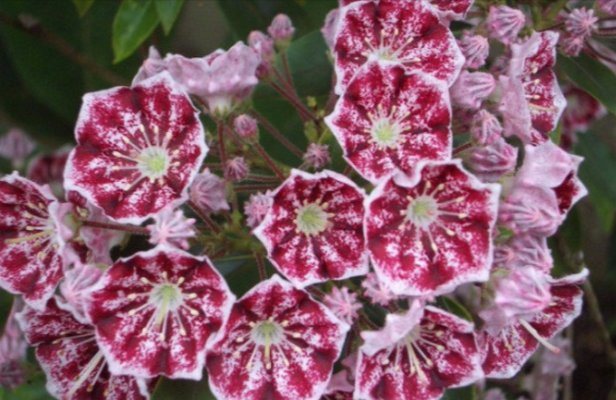

- "Carousel" - the variety is a compact, low bush with large white buds, decorated with purple strokes and dots;
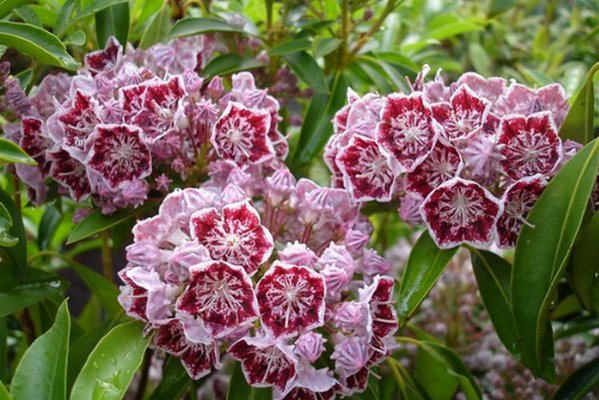

- "Elf" - differs in low stems that develop up to a maximum of 80 cm, and snow-white flowers with a scarlet "star" on the calyx;
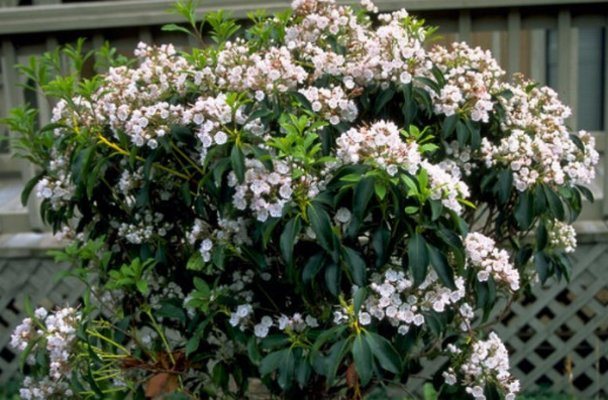

- "Black Label" - characteristic features of the variety are medium height, large flowers reaching 3.5 cm in diameter, and white-chestnut color of the buds;
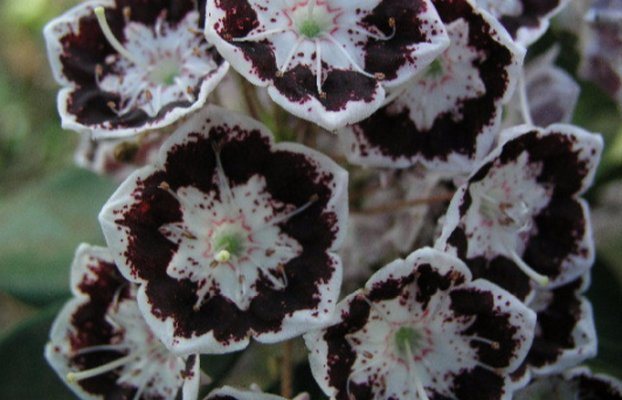

- "Ewa" - is a bush with a widely branched crown, which grows up to 1.3 m in diameter, and delicate pink inflorescences;
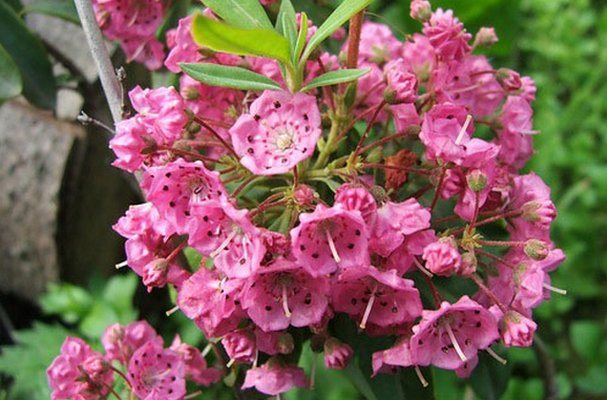

- "Bullseye" - blooms in purple buds with a white edging and an asterisk at the base.


This selection is able to withstand 35-degree frosts, but young plants require special preparation for winter.
Did you know? Due to its abundant and long-lasting flowering, kalmia is an excellent honey plant. But the delicacy absorbs all the toxic substances of the plant. Because of this, the ancient Greeks called him "insane" and used as a dope in the fight against Xenophon.
Photo gallery of views
How to choose seedlings when buying
Not only the survival rate of ornamental shrubs, but also their further development depends on the quality of the planting material. Therefore, the choice of seedlings must be approached very seriously and scrupulously.
Of course, it is better to make a purchase in specialized stores and garden centers with an impeccable reputation. Feel free to ask a lot of uncomfortable questions to sellers. On the contrary, you should be wary if they do not have complete information about their product and cannot satisfy your curiosity.
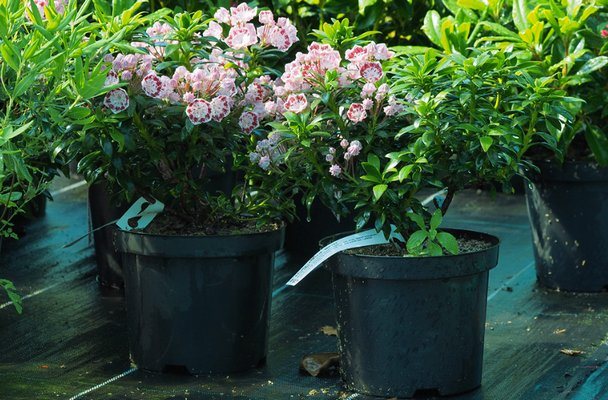

Try to find out as much as possible about the seedling of the variety you like. And then take a close look at its roots and stems. Many retail outlets today sell ornamental plants in closed-root containers.
In this case, it will be enough to assess the general condition of the flower and find out its age.
Experts advise buying exactly potted seedlings, since their root system receives nutrition and is devoid of the risks of drying out. In addition, capricious kalmia reacts very painfully to transplants. Therefore, it is better not to disturb her once again.
Important! Never buy seedlings with spots, blooms, growths, darkened and moldy circles on the roots and stems. It is also worth abandoning copies with mechanical damage.
A healthy seedling always has smooth and even stems. It is desirable that the plant has 2–3 lignified branches with a height of 10 to 20 cm (depending on the shape).Also, its roots should be well branched and fresh.
You can check this by making a small scratch on one of the processes. The light wood that appears indicates the quality of the product. Particular attention should be paid to the place where the root passes into the trunk. It should have a homogeneous structure, without any suspicious points and breaks.
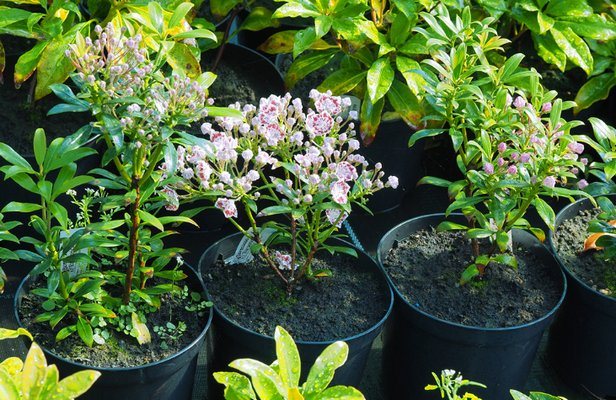

For cultivation in gardens and parks, choose 2-year-old specimens that have already wintered. They have a fairly developed root system and crown, which will contribute to rapid rooting and adaptation to winter.
Description and history of the plant
The calmia plant has a history of its own. It was discovered in the 18th century in North America, where it grew in almost all northern regions up to Alaska. The culture was discovered by the botanist-scientist Per Kalm, who was one of the students of Karl Linnaeus and participated in the expedition to the North American mainland. Upon arrival in his homeland, Per began to grow in his greenhouse. Having carefully studied the morphological characters, he created a description for each of the botanical plant species. He especially liked the broad-leaved squid, it was this variety that became typical for the entire genus of plants.


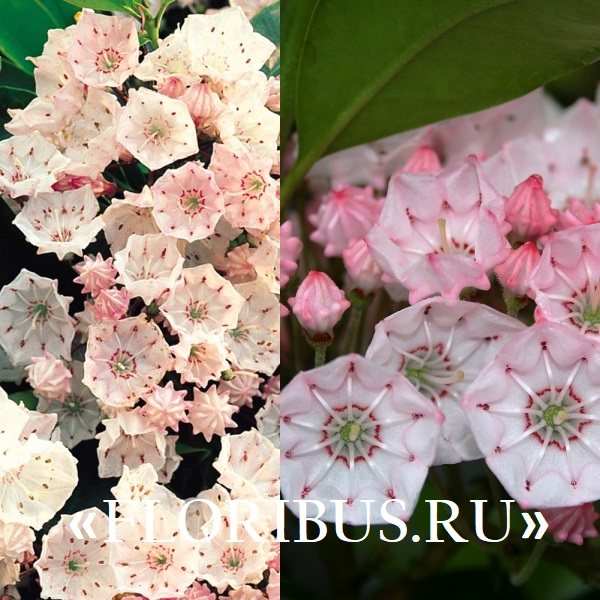

According to the botanical description, it is an evergreen perennial plant with woody shoots. Habitat - all of North America, where the plant grows in woodlands and undergrowth. In height, all hybrid and natural varieties vary greatly. There are specimens that grow up to 2 meters, and there are also more compact dwarf bushes - no more than 30 cm in height.
The leaf plates are dark green above and a bluish shade below. Leaves are elongated oval or lanceolate in shape. They are attached with long petioles to the stems. On the leaf blade, a central vein is clearly expressed, painted in yellow or red color.
It blooms in very early summer or more often in spring. At this time, very delicate white, pink or crimson buds are formed. The size of the flower - its diameter and length, depend on the species and hybridization. There are varieties with very large buds in powerful inflorescences, but on the contrary: with small, but very bright flowers.
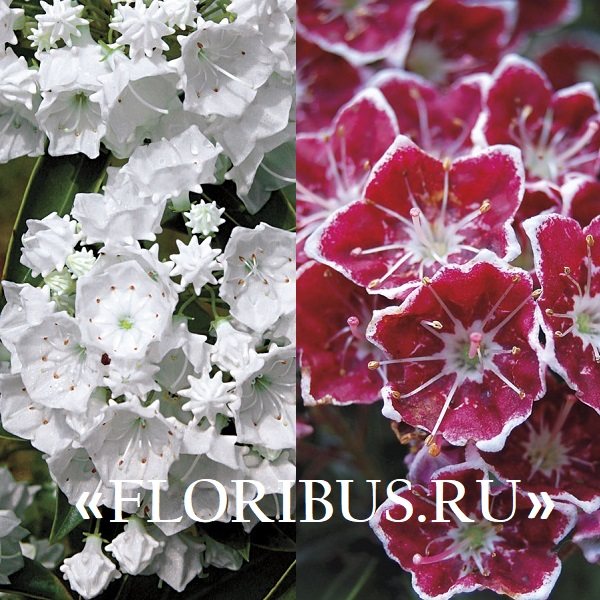

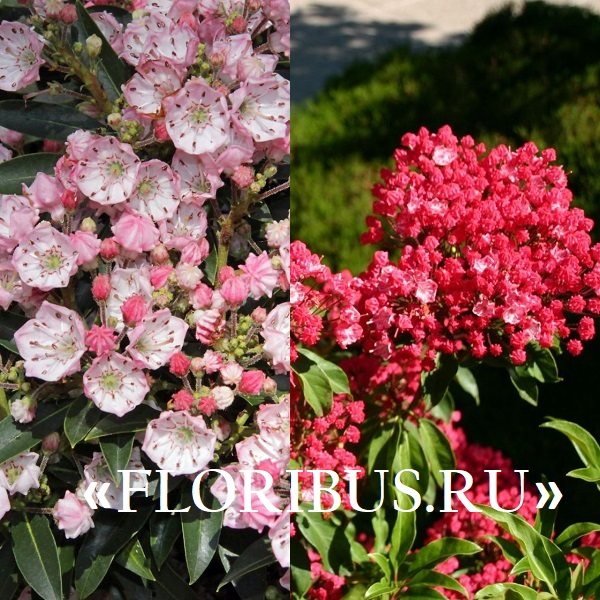

Calcium can be distinguished by the structure of the flower. She has clearly defined long stamens. They are needed for cross-pollination. When the flower is closed in the bud, the stamens fall into the petal pockets. When blooming, they are carried away by the movement of the whisk and remain energized. When a rather heavy insect sits on the bud, the stamens jump out like springs and shower the “guest” with pollen.
Frost resistance can be the envy of many Russian familiar cultures. For example, a narrow-leaved variety easily survives very frosty winters and a drop in temperature to -35..40 degrees. Also, a completely frost-resistant species can be called recumbent, thanks to the lodging stems, it is also easily preserved in winter, despite the fact that the perennial is evergreen and does not shed its foliage before cold weather.


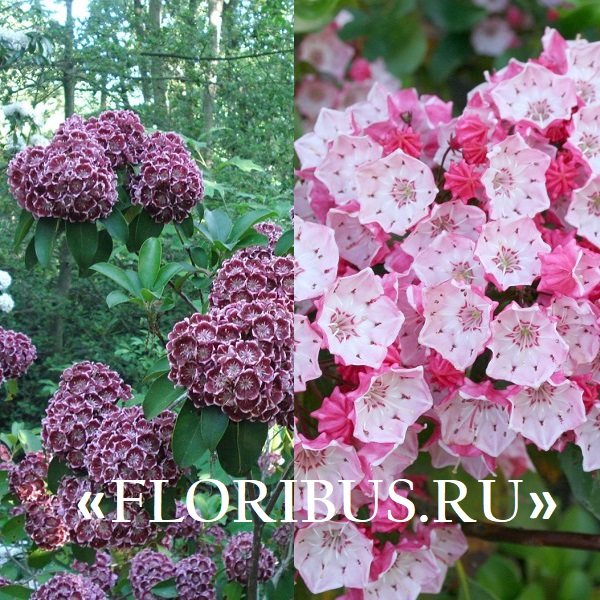

Seat selection
Mountain laurel is very picky about soil, lighting and temperature conditions. Therefore, the choice of a landing site is the most important stage in the preparatory work.
Take a closer look at your site. If rhododendrons or other representatives of the Heather family are already growing on it, then they will like the proximity of kalmia.
Important! All types of kalmia take root very poorly on sandstones and heavy loams. In the absence of other areas with light fertile soil, it is possible to improve the substrate with the help of high peat, coniferous litter, deciduous land and river sand. On depleted soils, you will also need compost. Moreover, it is necessary to apply the soil mixture in advance and in large quantities, so that the root system of the bush has the opportunity to eat.
For a flower, it is advisable to select a semi-shady zone away from the prevailing drafts and northern winds, in places where cold air, melt and rain water do not collect. The culture, although it loves moisture, but with its excess, as a rule, suffers from putrefactive infections and dies.


Kalmia is afraid of winter and spring sun rays. Therefore, it is advisable to place it somewhere under tall trees with sprawling branches.
When choosing a site for planting, it is worth considering the peculiarities of the soil composition. Shrubs feel comfortable on acidic or slightly acidic loose soils with good aeration and drainage. Avoid calcareous areas and materials - the plant is not able to put up with them and dies.
Multifoliate Kalmia
Many-leaved Kalmia (Kalmia polifolia) is commonly called "bog laurel", which is explained by the natural environment of the plant.
In the wild, it can be found in cold, swampy areas from Newfoundland to Hudson Bay.
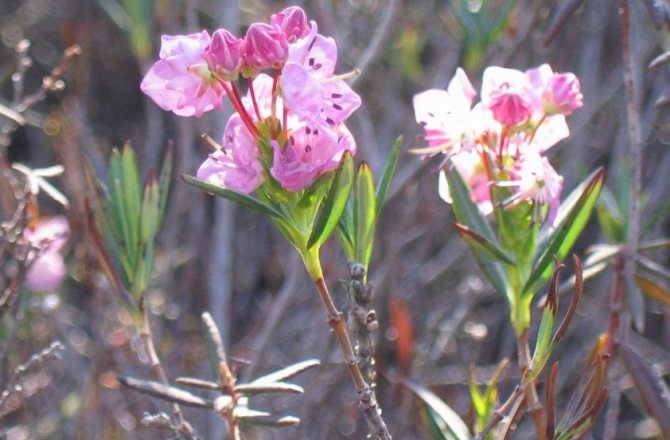

Important! To improve the substrate in the area where the planting of calmia is planned, experts recommend mixing 3 parts of peat and leafy soil each, and also adding 1 portion of coniferous litter and river sand. It is advisable to add mineral complex fertilizers to the substrate at the rate of 1 tablespoon per planting pit.
Not all scientists recognize this type of calcium. Among the distinctive characteristics of its supporters, they note a strong, well-developed root system of a shrub, an evergreen neat crown, which reaches no more than 60 cm in diameter. Ascending stems of the culture develop just above half a meter.
A specific feature of the many-leaved species is the purple bark on young branches, and as they age, it turns gray. The foliage of the shrub differs from the above-described varieties in its small size and density. Due to the dense biomass, the compact crown is more rounded, which gives the culture a special decorative effect.
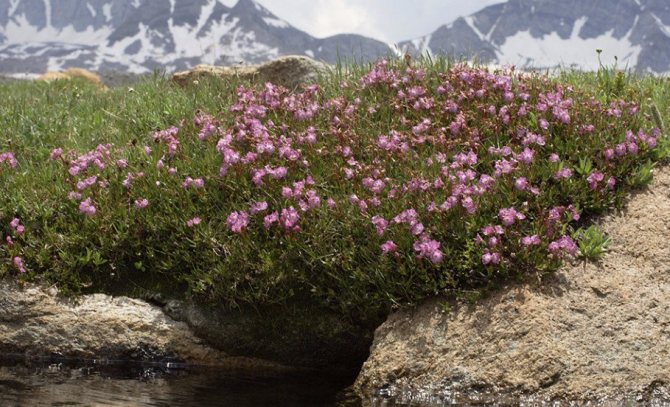

On the tops of the branches there are single scarlet flowers in the form of bells. The shrub begins to bloom much earlier than its counterparts - in April. Its growth is very slow.
Step-by-step landing instructions
Gardeners who have a solid experience in the cultivation of heather plants are advised to root kalmia in the spring. This process is preceded by a thorough preparation of the site and the seedling. Let's figure out all the stages one by one:
Did you know? An unknown plant, which eventually became known as "kalmia", was discovered
botanists on the North American coasts in 1624.
- In the fall, dig deep into the selected area and correct the soil. Even in fertile areas, it will not hurt to introduce a nutrient mixture of equal parts of river sand, compost and double portions of high moor peat, deciduous soil and coniferous litter.
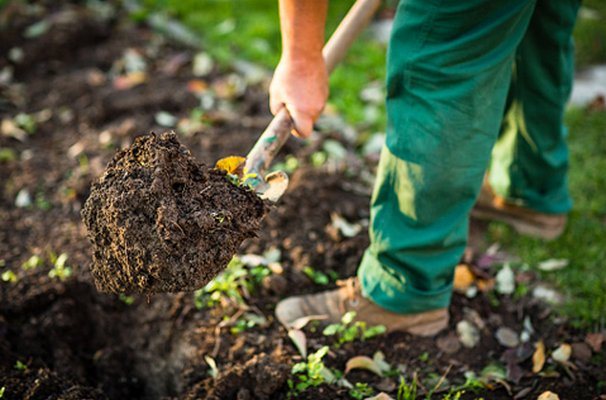

- If you purchased a seedling with an open root system, be sure to put it in water for a day. To improve further growth, add a growth stimulator (Kornevin, Ecosil) to the container. After that, dip the rhizome in a special clay mash. It will protect the roots from drying out and allow the plant to use resources for quick adaptation to new conditions.
- In the spring, when the weather is stable outside and the ground warms up enough, dig a planting hole of the appropriate size. Often a square depression is made with 60 cm sides and a depth of 40 cm.
- Be sure to lay drainage at the bottom of the hole. For these purposes, broken brick, expanded clay and any other materials, except for the well-known crushed stone, are suitable.


- Pour fertile soil on top (you can use the mixture that was prepared in the fall to adjust the site) so that the hole is filled by a third.It is advisable to add 1-2 tablespoons of mineral complex fertilizers to each hole (do not forget to mix them with the soil mixture).
- Cover the prepared recess with plastic wrap and leave it for a week so that the microflora necessary for the flower forms there and the soil shrinks.
- Insert a seedling into the hole and gently spread its roots. If you are dealing with a container, carefully roll over the earthen ball without destroying it and place it in the hole.
- Water the flower well. Moreover, this must be done until the earth ceases to absorb moisture.
- Cover the roots with soil, tamp it thoroughly and mulch the trunks with peat or needles. These materials contribute to the oxidation of the substrate, therefore they are desirable for all types of calcium and other heather counterparts.


Important! When planting kalmias, make sure that their root collar is located at soil level. Otherwise, the shrub is threatened with drying out or rotting.
Disease and pest resistance
This shrub is very resistant to pests and diseases. Very rarely, if the plants are not watered correctly, they can be affected by fungal diseases. With a local lesion, diseased leaves are removed and burned.
If the fungus has covered many parts of the shrub, it is recommended to spray the calcium with Benlate solution or another fungicide with the same method of action.


Use in landscape design and selection of partners
There are also some fashion trends in landscape gardening design. And, despite their changeability, interest in beautifully flowering decorative perennials will never lose its relevance.
This also applies to kalmia, even in spite of its poisonous secret, which is hidden behind the refined beauty and tenderness.
In the garden, such a shrub will decorate any area. Many designers like to create eye-catching compositions of calmias and rhododendrons. Different periods of their budding allow a fabulous atmosphere to reign on the site throughout the warm season.
Single shrubs also look good against the background of a green lawn or under the cover of a lush crown of a tall tree. In the Japanese style, it is very customary to plant kalmias on alpine hills, especially since the broadleaf species is adapted to rocky conditions.
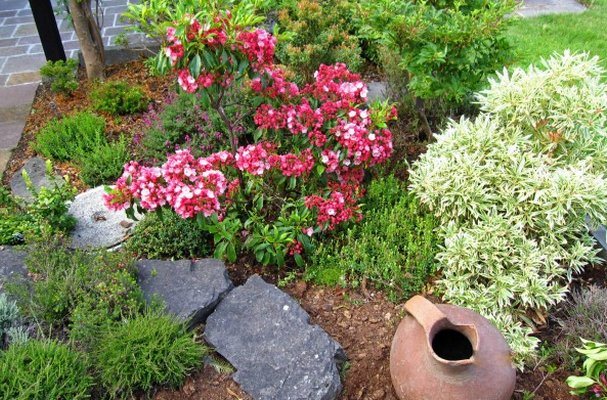

Garden specimens of these plants are often found as a decoration for alleys, a central entrance to a house or a gazebo. These shrubs are planted in the best areas to create a cozy and festive atmosphere at the same time.
The flower feels good in the neighborhood of all heather cousins, as well as all conifers and marsh crops, wild rosemary, erica, ferns and common whitewash.
Did you know? In medicine, andrometoxin is widely used, which is present in small-leaved calcium. The substance is an integral component of external remedies for skin diseases.
Decorative use
Kalmias, despite their health hazards, are very often used for landscaping. Plants are prized for their beautiful flowering. Low-growing varieties are planted in rock gardens and stone gardens, from which you can form a very beautiful border that retains its decorative effect all year round. In joint plantings, it can be grouped with rhododendrons and other plants from the Heather family.


Group planting on a slope with ferns
Combinations with conifers and ferns look very attractive. All the beauty of the shrub can be seen in a single planting, therefore they are often planted near the porch. Growing in flower beds with flowering annuals is also permissible, in which case plants that bloom earlier or later kalmias are selected as partners.
How to care
It only at first glance seems that the capricious kalmiya will exhaust all the strength from you when caring for it. In fact, a flower needs a little attention and knowledge about its requirements for watering, feeding, pruning, preparing for winter.Let's take a closer look at all the subtleties of crop care.
Watering and loosening the soil
This flower loves moisture, but cannot tolerate excess of it. Therefore, the bush should be watered as the upper ball of soil dries up in the near-trunk circle. In hot weather, be sure to moisten the roots and crown of the exotic.
Do this in the morning or evening so that the sun's rays do not damage the foliage. It is enough to moisturize Kalmiya 2-3 times a week. Pour 2-3 liters of water under young shrubs each time, and mature specimens will need about 10 liters. In a drought, sprinkle the crop.
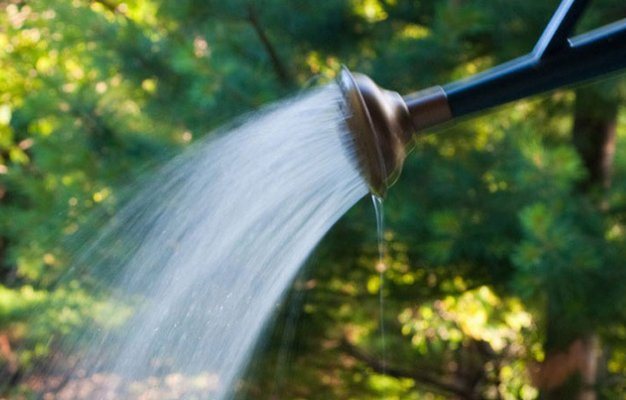

Each watering should end with loosening the soil. Do not allow weeds to rage on the site, and a hard earth crust forms in the near-stem hole.
In such conditions, you deprive the flower's root system of oxygen and nutrients. Therefore, do not be lazy to periodically process the area with a hoe and renew the mulch layer as necessary.
Important! Experienced gardeners are advised to water heather crops (which include kalmia) with acidified water. To do this, it is enough to add 20 g of table vinegar or a tablespoon of citric acid to a bucket of liquid.
Top dressing
After planting a young kalmia seedling, you can forget about fertilizers for the next 2-3 years. Then it is advisable to feed the bush at least once a season with the same interval. It is best to plan these procedures between April and June.
For these purposes, it is best to use mineral complex fertilizers for rhododendrons. Do not forget to pay attention to the "spring" or "autumn" packaging markings. In the absence of purchased funds, you can use organics.
Keep in mind that varietal Calcium hybrids require much lower nutrient concentrations than conventional varieties. In the spring, it is advisable to add a urea solution (1 tablespoon per bucket of water).


At the peak of the growing season, the flower requires slurry from 1 portion of a solution of chicken manure or mullein and 15 parts of water. It is enough to pour 3-5 liters of liquid under each plant.
Particular attention should be paid to the plant during the flowering period, since the abundant inflorescences greatly deplete the culture. In autumn, it is advisable to feed it by sprinkling Kemiru Universal under the crown.
Important! The foliage, which has turned pale on the back, speaks volumes about the need to apply fertilizers under the calmia bushes. Be careful, because the inner side of the leaves of all varieties of these plants naturally has a pale tint, which sometimes acquires a bluish tint.
Pruning
Considering the slow pace of shrub development, you can relax and enjoy the beauty of its bloom. Over the course of a year, the plant grows weakly and only by the age of 10 reaches its standard volumes, which, depending on the variety, fluctuate between 60–130 cm. The branches of the bush, without human intervention, tend to form a compact, neat crown. Consequently, the plant does not need formative pruning, although it tolerates it easily.


Experts advise to monitor the shrub and carry out its timely cleaning of damaged, old and dead branches. If desired and skills from kalmia, you can create a beautiful blooming figure.
In addition, it is advisable to remove faded buds from the bushes in time so that the plant does not waste energy on their maintenance.
Plant propagation
There are several ways to propagate this plant:
- seeds;
- green cuttings;
- layering and root shoots.
Only none of these methods can be called easy. For seed propagation, the seed is harvested in the fall, dried and stored cool in a dry place. To improve germination, it is better to keep the seeds in the cold for about 2-2.5 months. Then in early spring they are sown in containers, and about a month after planting, they sprout.
Perhaps the reproduction of kalmias by layering will seem a little easier. If root shoots have appeared, the young plant must be carefully separated from the mother plant, so as not to damage the roots, and planted separately, but there is no guarantee that it will take root.
Of course, broadleaf Calmia is a difficult plant to grow. But on the other hand, it blooms very beautifully, and its foliage is quite decorative. Therefore, to decorate your site, you should at least make an attempt and try to grow this beautiful shrub with delicate flowers.
M. maritima (M. primorskaya)
Flowers with a delicate aroma, about 2 cm across, red, lilac, pink or white, in loose racemose inflorescences on thin branching stems. This hardy perennial native to the Mediterranean has elliptical gray-green leaves up to 4 cm long.The height and diameter of the plant is 20x36 cm.


Flowers with a delicate scent
Sources of
[collapse]
Rooting green cuttings
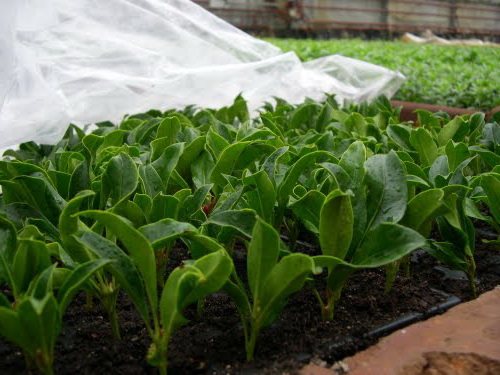

Calmia cuttings
Not the best way, because the cuttings take root very badly. In early spring, before the start of sap flow, cut the apical cuttings 10-15 cm long, make the lower cut at an acute angle, treat with a fungicide and hold the cuttings in a growth stimulator. Remove the leaves from the bottom, and shorten the rest by 1/3 of the length.
- Plant the cuttings in a shared wide container or individual pots.
- Create conditions similar to germination from seeds: shelter (containers are covered with glass or foil, cuttings in separate containers can be covered with a glass jar or a cut plastic bottle), temperature regime, lighting, ventilation and soil moistening. Take the same rooting substrate.
- When the cuttings take root, the shelter can be removed.
- Plant it outdoors the following spring.
African and seaside malcolmia
Of all the species as garden cultivars in our country, only two are popular: African malcolmia and seaside. They got their names due to their belonging to a certain habitat. In the first case, African countries are considered to be the homeland, in the second - Greece, the Mediterranean Sea. They differ among themselves in growth and decorativeness, which can be noted in both species in the photo below:




African malcolmia is an annual garden crop common in Russia that does not withstand cold and especially frost. It differs from another, more popular representative of the genus in lush, tall bushes up to 50 cm in length. Stems and leaves are abundantly covered with pale long hairs. Blooms in pink, lavender or pale purple buds composed of 4 corolla petals.
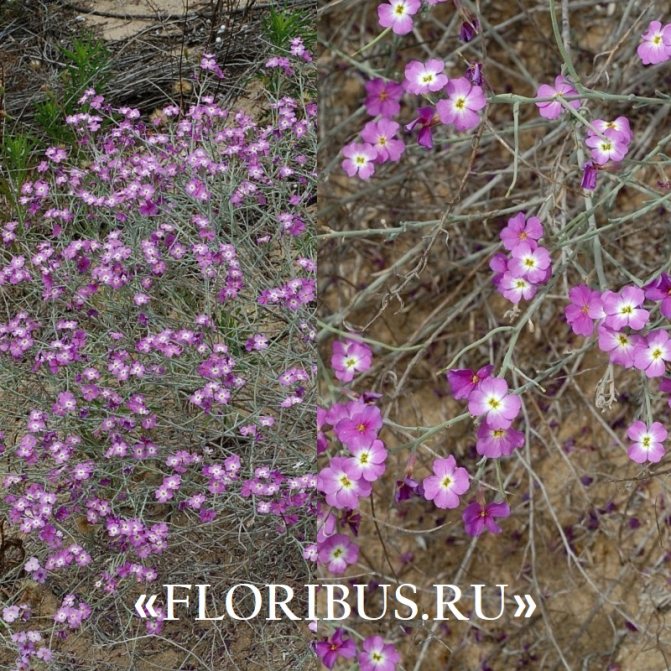

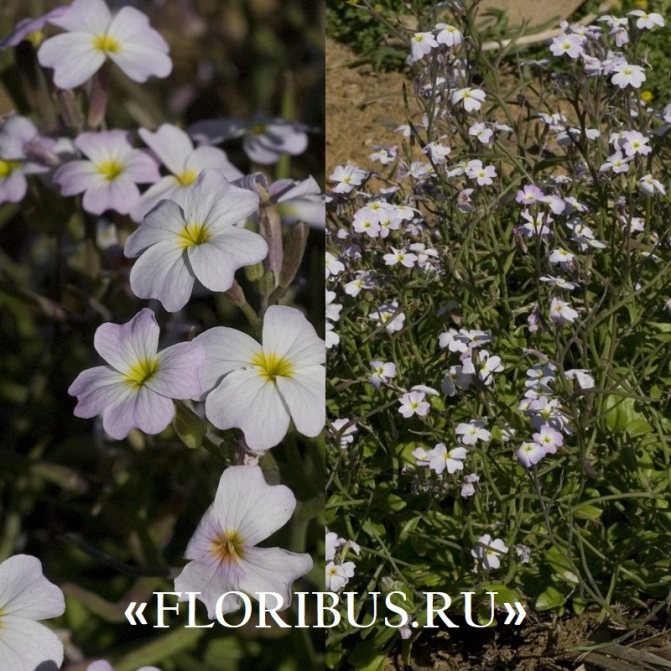

The most popular horticultural crop of the genus is considered to be the seaside malcolmia - this is a short (up to 20 cm) herbaceous bush with abundant flowering. Gardeners consider this species to be the perfect curb plant. Thin stems are erect, develop very quickly, having small ovoid or lanceolate leaf plates of a green tint on themselves. The pubescence is not as abundant as in the African variety, but it is also present. During the growing season, small (up to 1 cm in diameter) four-leafed buds of pink, white or purple hue are formed. Primorye Malcolmia gained its popularity for its resistance to cold weather - its flowering is very long: from the end of June to the first frost.




Preparation for planting narrow-leaved Kalmia in open ground
Calmium is planted in a prepared area. Healthy and strong plants are chosen for planting. With the right choice of place for growing, kalmia will delight you with abundant flowering and a long lifespan.


Photo: <>
Landing dates
In Russian regions, it is better to plant ornamental trees and shrubs in the spring. During the season, the plant will have time to take root and adapt to new conditions.Planting work is carried out in April-May, when the soil and air are well warmed up. If spring frosts are expected, planting should be postponed. To protect the planted kalmia from a cold snap, use a film or agrofiber.
Choosing a place on the site
In nature, Calmia prefers shaded areas where there is no constant exposure to the sun. The flower is planted next to trees, shrubs, buildings, fences, reservoirs. Perennial flowers develop well in open areas, but require more intensive watering. To protect the plant from direct sunlight, in hot weather, artificial blackout is created using a canopy. A flowerbed is laid out on a flat area or a small elevation. In the lowlands, cold air and moisture accumulate, which slows down the development of calcium.
Soil preparation
Under natural conditions, Calmia grows on acidic soils. Perennial feels good in fertile soil with high levels of air permeability and moisture. Before planting a flower in clay soil, it is recommended to add several buckets of coarse river sand. Such soil allows moisture to pass through better. The use of humus and peat will help improve the properties of sandstone. Calmia substrate is obtained by combining peat, sod land, sand and coniferous sawdust in a ratio of 3: 2: 1: 1. Add 50 g of any complex fertilizer to each planting hole.
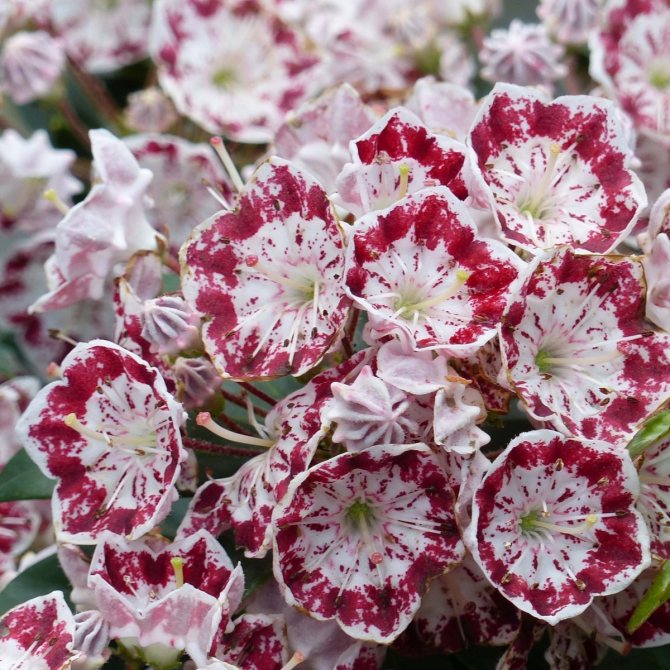

Photo:
Plants are not planted in soil with a high content of lime and peat. In such soils, the flower loses its immunity, is more susceptible to diseases and temperature extremes. Stagnant moisture is detrimental to the plant. An additional drainage layer helps to avoid its accumulation. The area for narrow-leaved calmia begins to be prepared in the fall. The soil is dug up, after which the necessary components are added. In the spring, deep loosening is performed and planting begins.
Selection and preparation of planting material
Calmia seedlings are best purchased from trusted suppliers. Plants are judged by their appearance. Healthy seedlings have dark green leaves and a developed root system. Bushes with thin shoots do not take root well in a new place.


Photo: <>
Calcium is sold in containers. Shoots and roots should not show signs of damage or decay. Before planting, containers with plants are stored at temperatures from 0 to +2 ° C in a refrigerator or cellar. With a rise in temperature and good lighting, flower growth is activated. Plants are kept at room temperature 2-3 weeks before planting. For the first week, the calcium is not exposed to the sun. The flower is placed in a shady place.
Let's summarize
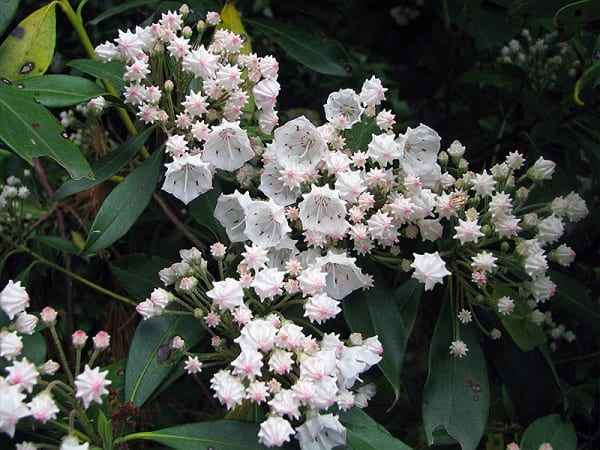

- There are only 4 cultivated species of Calmia, of which broadleaf is probably the most spectacular and popular.
- The plant is thermophilic, so it should be grown only in the southern regions of Russia and Belarus. In Ukraine, it is grown throughout the territory, but they must be covered for the winter.
- Calmia is planted in spring, in sour and light soil. The place should be chosen in partial shade.
- Plant care is simple: watering, three dressings per season, pruning. You need to be careful with the bush - all its parts are poisonous.
Kalmia is not only a bright flower "picture". This plant is often used in folk medicine... For example, with such diseases:
But do not rush to dry flowers and throw them into tea without consulting a doctor! The fact is that broadleaf squid is not only an active, but also a dangerous plant. If the flower is not applied correctly, he can kill... The following video will tell you about the dangers of calmia (as well as other popular garden plants):
Preparing for winter
The winter hardiness of narrow-leaved kalmia is -40 ° С. With a high snow cover, plants are not susceptible to freezing. Water abundantly before autumn frosts, this will help the flowers to endure the winter. Moistened soil freezes more slowly, and kalmia is protected from frost. 10 liters of water are added under each bush.In autumn, the shrub is treated with iron vitriol. Spraying allows you to get rid of the larvae of pests and pathogens. A 3% solution is prepared for processing.
Dry leaves and spruce branches are used to cover the shrub. A wooden frame is installed over low-growing plants. A mulching layer is poured onto it. Calmia is covered with the onset of a stable cold snap. It is not recommended to use plastic wrap, under which plants are blown out during spring warming. It is better to replace the film with agrofibre. In winter, snow is thrown over the plant. In the spring, the shelter is removed. The layer of mulch is also removed so that the root collar of the flower warms up faster.
Caring for narrow-leaved salsa in the open field
Narrow-leaved Kalmia is an unpretentious flower that is resistant to unfavorable climatic conditions. When growing calmia, they provide regular watering and fertilization.
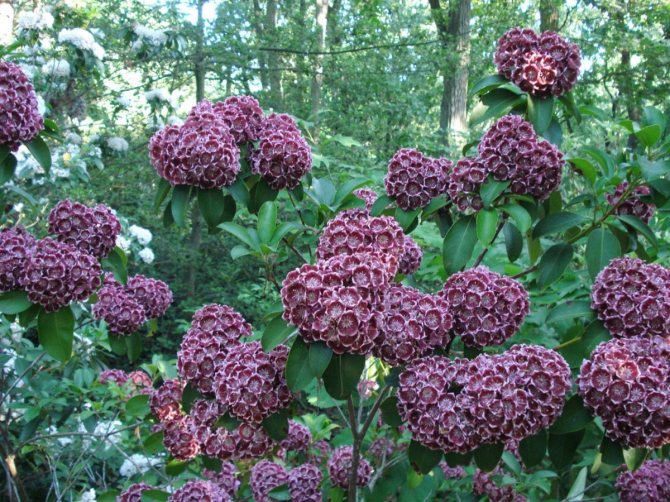

Photo: <>
To stimulate new shoots, pruning is carried out. With proper planting and maintenance, the plants will not get sick and will not be attacked by pests.
Watering rules
Narrow-leaved Kalmia is able to withstand a short drought. The watering rate depends on the weather conditions. With regular precipitation, no moisture is required.
Tip: In dry conditions, water the plant twice a month. Add 10 liters of water under each bush.
For irrigation, use warm, settled water. Exposure to cold water from a hose is stress for plants. Powerful jets erode the soil and expose the roots, which negatively affects the development of the flower. Moisture is applied in the morning or evening, when there is no direct exposure to the sun. When watering, make sure that water does not get on the leaves and stems.
Terms of top dressing
The use of fertilizers ensures the active growth of kalmia and the formation of inflorescences. At the beginning of the growing season, nitrogen fertilizers are applied under ornamental trees and shrubs to build up the green mass. In early spring, a solution is prepared consisting of 7.5 g of ammonium nitrate per 2 liters of water. Fertilizer is applied at the root.
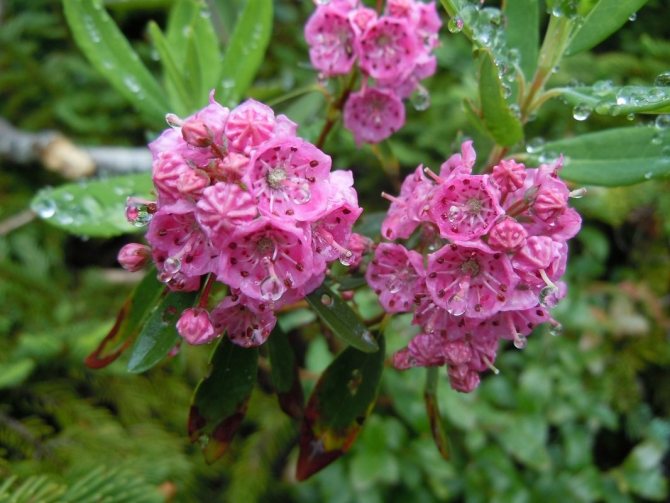

Photo:
When the growing period begins, the flower is fed with slurry at a concentration of 1:15. 3 liters of solution are poured under the bush. In autumn, the Kemira complex fertilizer is applied to the soil. It contains nitrogen, potassium, phosphorus and selenium. 100 g of fertilizer is used per 1 m2. Dry granules are scattered over the beds.
Loosening and mulching the soil
After rain or watering, the soil in the flower garden is carefully loosened. The root system of kalmia is located at the surface of the earth. Therefore, when digging, they try not to damage the roots of the plant.
Loosening improves air exchange in the soil. As a result, the flower absorbs moisture and nutrients better. It is important to ensure that no crust forms on the surface.
To retain moisture in the soil, mulching with organic matter is performed. A layer of peat or humus 5 mm thick is poured under the shrub. Mulch does not inhibit weed germination.
Pruning
To stimulate profuse flowering, dry inflorescences are pinched. In the fall, dry and damaged shoots are also eliminated. In the spring, you need to remove the frozen parts of the shrub.


Photo:
In the summer, shoots that thicken the bush are eliminated. Sparse ornamental trees and shrubs develop better and produce more inflorescences.
General information about the shrub


A charming branchy shrub with unusual lanceolate oblong leaves. Their length reaches 6 cm. From above they are green, and from below a bluish tide is visible. Their tips are pointed, which resembles bay leaves.
With the onset of summer, delicate cupped flowers appear on numerous stems. They are:


Interestingly, the buds are collected in small umbrella-shaped bouquets. Each of them reaches up to 1 cm in diameter. When the shrub blooms, a huge number of such delicate inflorescences appear on it. In this photo, kalmia amazes with its charm and beauty.
There are many different varieties of overseas shrubs that grow well in Russia. Many of them are quite winter-hardy, therefore they are used in summer cottages and in the Moscow region. One of these varieties is broadleaf Calmia.
Care features
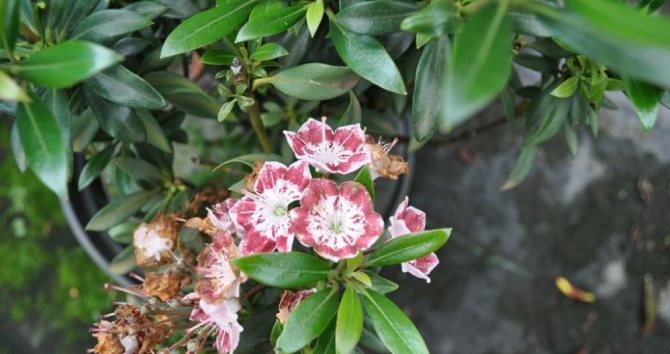

Calcium care is as follows:
- In summer, in extreme heat, water the plant with settled water as needed. It is recommended to water the kalmias every 14 days, 10 liters for each plant. With stagnant water at the roots, the shrub can be affected by late blight. If a heavy downpour has passed, the soil must be plowed. In this case, it is necessary to act carefully so as not to damage the roots located in the upper layer of the soil. In the fall, before wintering, abundant watering of the soil under the bushes is also important.
- In the spring, you need to feed the plants with mineral fertilizers. Top dressing is carried out from the second year of growth. Also in the spring it is necessary to mulch the soil.
- Since the calcium does not grow very much, pruning is not carried out. Usually a plant has only 5 centimeters of growth per year. It is only important to remove faded inflorescences. In the spring, some gardeners can optionally shape the shrub by cutting off the protruding shoots.
- Calmia tolerates severe frosts. But there are varieties that need protection from frosty weather. They also wrap up very young seedlings for the winter.
In order for the calmia to grow well and bloom profusely, it is important to follow the listed rules for caring for the plant.
Rules for buying seedlings


It is best to buy seedlings from trusted suppliers who have been selling plants for many years - they will not risk their reputation and will not offer low-quality bushes.
The seedlings should have dark green leaves. It is better not to buy plants with leaves only at the ends of the branches - this means that they have felted roots and they will grow poorly. Seedlings should be sold in containers. There should be no damage to the leaves and branches.
Cultural species and varieties for Russia
All over the world, calcium is known as a very resistant plant. It is not afraid of severe frosts and easily survives at temperatures of -40 degrees. But, of the cultivated species suitable for cultivation in Central Russia, only one stands out - narrow-leaved squid. In other warmer regions, it is possible to grow broadleaf and multifoliate salsa.


Narrow-leaved Squid
A variety of perennial narrow-leaved kalmia was brought from eastern North America. The popularity of the plant has led to the emergence of numerous interesting varieties. There are specimens up to 150 cm in height. Also, in the palette of interesting varieties there are dwarfs, up to 30-40 cm in height. For example, such is the popular hybrid "Gnome". It blooms in gardens from about the beginning of June. Flowering continues for 30-40 days. At this time, numerous small flowers are formed on the bush, collected in corymbose or umbellate inflorescences. The color of the buds depends on the varietal form. For example, the variety "Alba" is presented with white flowers, with purple "Purpleflor", and with red and scarlet "Rubra". In other sources, especially historical narrow-leaved kalmiya is found under the name "sheep laurel".
No less attractive are the two most famous varieties - "Minuet" and "Vanilla Cream". The minuet has beautiful flowers of variegated color - from white to rich wine. "Vanilla cream" has white buds, more often a slightly creamy shade.


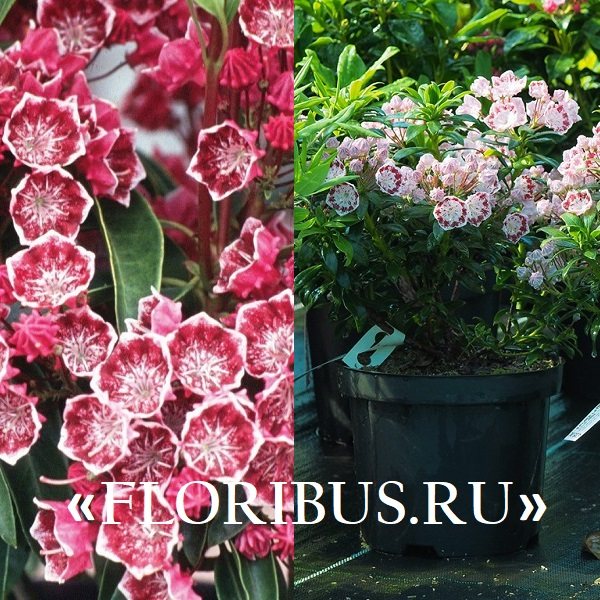

Broadleaf Kalmia
The typical species for the entire genus of plants has become broadleaf squid. It is grown in Russian regions with temperate or warm climates. Unlike other species, the plants of this variety grow up to 2.5 meters in height. They develop rapidly outdoors and bloom in small bright flowers up to 2.5 in diameter. The shrub has wide leaf plates and more than 10 cm in length. Of all the varieties, it is this one that has a unique decorative appearance.Therefore, on its basis, many hybrid varieties for the garden were created.
Large flowers and abundant flowering were noted in hybrids called Pink Charm and Little Linda. Large-flowered forms are grown in warm zones as a garden plant. Also, the "Elf" variety with small white umbellate inflorescences is very attractive. Like a snowdrift in the garden, the Calmia "Snowdrift" stands alone. The variety blooms very profusely with small numerous flowers of snow-white color. They are collected in large umbellate inflorescences, as can be seen from the photo of the hybrid below.
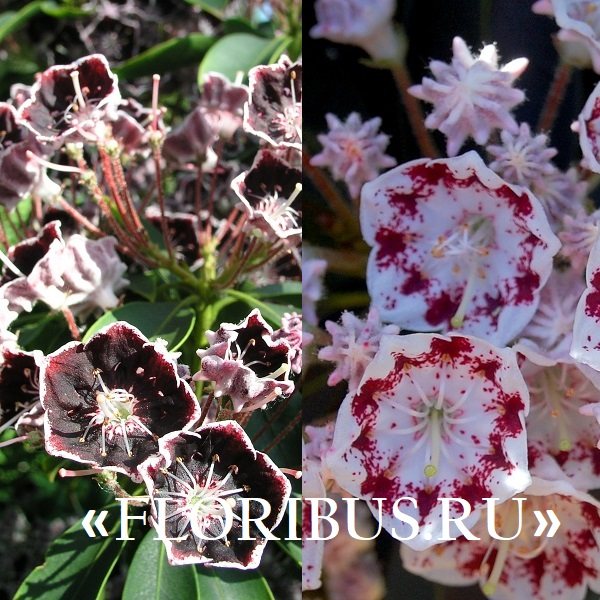



Multifoliate calmia
The attention of flower growers was also attracted by the multi-leaved kalmia, which pleases not only with bright flowers, but also with an openwork pillow of foliage. The perennial reaches a height of no more than 1.8 meters. At the same time, the bush does not grow much and develops relatively slowly. The most popular variety with purple flowers in Russia.


Lying Calmia
A small shrub common in the Northern Hemisphere is the recumbent squid. Unlike other species, woody shoots tightly press the shrub to the soil. Therefore, the perennial is most often grown as a ground cover specimen. The variety is considered monotypic and includes 1-2 typical natural varieties. It is difficult to hybridize. The specimen does not bloom as abundantly as other species, therefore it is less often used in floriculture.


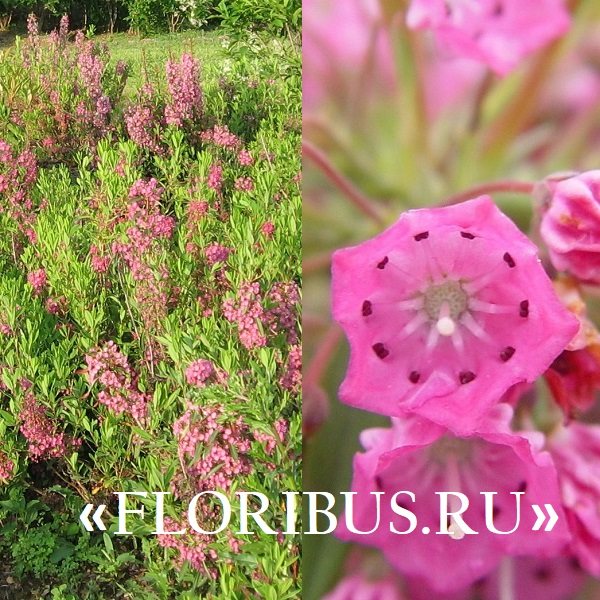

Growing Calmia from Seeds
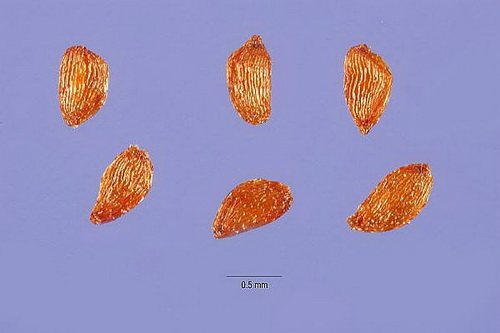

Calmia seeds
Calmium is grown from seeds in seedlings. The seeds are purchased at specialized points of sale, but they are quite rare. If, by a lucky chance, your friends have a magnificent kalmia growing on the site, collect the seeds yourself.
Dry the seeds, put in a paper envelope or cloth bag, and store in a cool dry place. Sowing should be started in March, but the seed needs preliminary processing. 2-2.5 months before sowing, get the seeds from a secluded storage place and send them to the refrigerator for stratification.
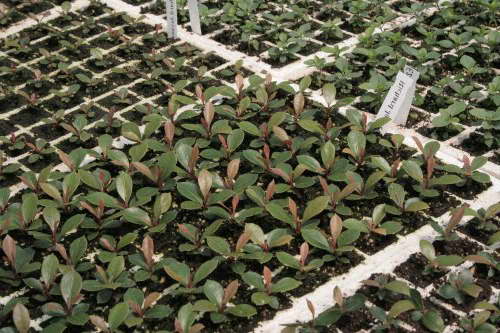

Calmia seedlings photo
- For planting, you will need containers with loose, acidic nutrient soil (a mixture of peat and sand is suitable).
- Spread the seeds over the soil surface, irrigate with a fine spray, and cover the top with oilcloth or clear glass to maintain the greenhouse effect.
- Lighting will need bright diffused, maintain the air temperature within 22-25 ° C.
- Seeds germinate within 3-4 weeks, do not forget to raise the shelter daily for ventilation, periodically spray the soil surface.
- With the appearance of shoots, you can remove the shelter, thin out the dense shoots.
- At the stage when 3-4 true leaves appear, plant the senets in separate pots.
- Further care consists in moderate watering.
Ideally, seedlings are grown in pots for 2 years, and transplants into open ground are carried out in spring or autumn.
Reproduction of kalmia independently and with seedlings
To get a beautiful plant for your garden, you can purchase healthy seedlings from the manufacturer. But, some growers are independently engaged in plant propagation. This is not an easy task and requires a long time and patience. Calcium can be propagated in several ways. Vegetatively: root shoots, layering or cuttings, or generatively (seeds).
If you are doing cuttings, then you need to be patient. Shoots take root very hard and it takes a lot of time. This is done in peat-based nutrient mixtures with a strong drainage layer. But this technique is rarely practiced even by very experienced gardeners due to the complexity. Rooting by layers is a little easier. But, this will take not a single year. An escape is taken and grounded in a small trench. In the first year, the layer is watered moderately. She will begin to take root only next season.It is possible to dig out the layering only a year after the appearance of a full-fledged root system. Only then can the cut be used as a full-fledged seedling for reproduction.
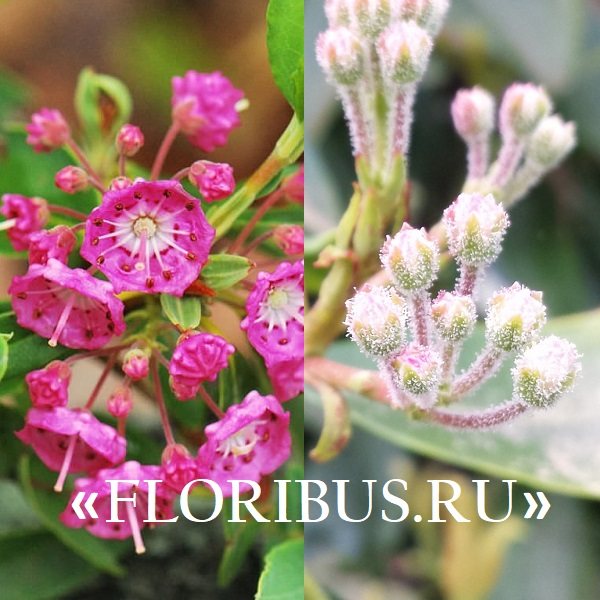

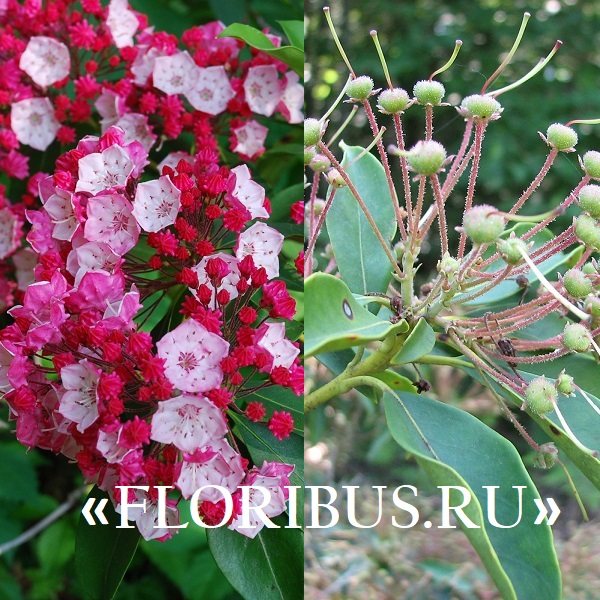

Growing features
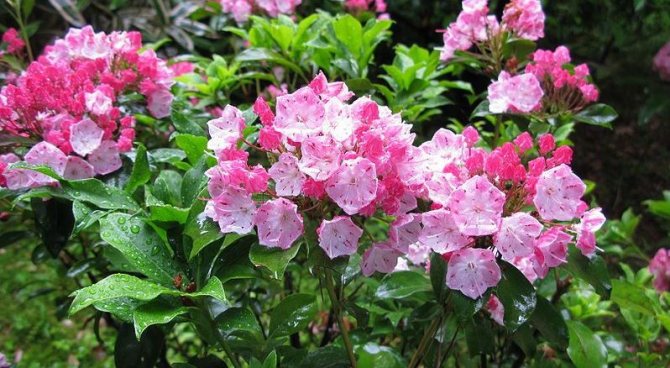

Narrow-leaved or broad-leaved Kalmia grows best on loose, moist, acidic soil, without lime. On hot summer days, it needs frequent and abundant watering. Also, the bushes are sometimes trimmed to create decorativeness and harvest faded flowers. It is important to fertilize the plant with special substances for better growth and flowering.
Seat selection
Since the leaves of the plant can burn in the sun, it is recommended to plant it in partial shade or shade. The sun's rays can harm not only the leaves, but also the flowers and branches of the plant. Planting should also be done in locations protected from winds and drafts.
Narrow-leaved Kalmia is a poisonous plant, therefore all parts of it are considered hazardous to health. The pollen and nectar collected by the bees cause weakening of the pulse, a drop in blood pressure and convulsions. Therefore, a plant of this type is grown only as an ornamental shrub.
Soil selection
In nature, Calmia grows on acidic, dry, sandy soil. In the garden, you need to make the soil acidic, fertile and loose. You can mix garden soil with pine needles and peat.
Calmium should not be planted in clean peat or heather soils, as it will become less resistant to various unfavorable environmental conditions.
It is also important to make drainage in the pits when planting, avoiding rubble. The drainage layer is usually made of broken brick mixed with sand. The drainage thickness should be at least 15 centimeters at the depth of each hole. When planting, it is also important to ensure that the root collar is level with the soil.
If you are going to plant several plants, make a distance of 80 centimeters between them.
General information
Currently, calcium can be found in Europe. After hard work, plants are now growing in the suburbs.
The leaves of the shrub are oblong, with sharp tips, similar to bay leaves, up to six centimeters long. Above, the leaves are saturated green, and if you look from below, you can see bluish shades. In the summer season, flowers appear on the shrubs, which are in the form of cups.
The flowers have different shades: crimson, red, patterned, white, cream.
Astounding facts
Nature never ceases to amaze and has provided kalmium with an interesting adaptation to cross-pollination. Even in the unopened corolla, the upper part of the stamens fall into special fold-pockets on the petals. As the flower unfolds, the petals carry the stamens along, thereby creating tension in the filaments.
The "membranes" under the weight of a large insect move and go beyond the bend of the petals, then straighten out from the springy actuation of the filaments, the anther slaps on the insect, generously showering the latter with pollen.
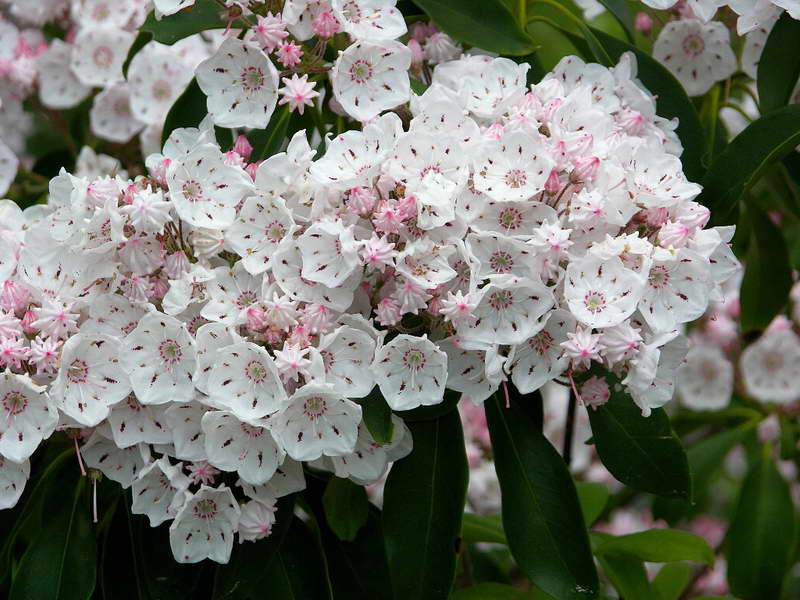

Flowers Calmia Plant Calmia Shrub Calmia photo
The genus is named after one of the students of Carl Linnaeus, Pera Kalm - a botanist who participated in an expedition to North America, later he grew some species of imported plants, including calmia. Of the ten species, 2-3 are currently cultivated.
Kalmia has high decorative qualities, its beauty is compared with rhododendron, hydrangea. Throughout the year, the plant keeps a leaf cover, and during the flowering period it is covered with the most delicate inflorescences, like fluffy clouds. In our country you will not find such beauty everywhere.
Calmia cultivation has its own characteristics and nuances that you need to familiarize yourself with in order to avoid disappointment. Also, keep in mind that all parts of the plant are poisonous, so be careful when handling the calcium. Avid florists, inspired by the appearance of a plant of incredible beauty, are not afraid of any difficulties.
Charming garden beauty kalmia: planting, care and photo
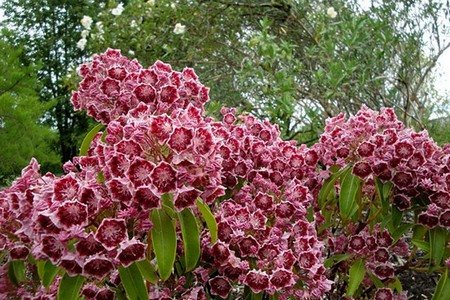

When it is time for plants to bloom, the garden becomes a unique place of delight. Especially if a perennial shrub grows in it - kalmia. The plant belongs to the Heather family. It was first discovered in North America. There, the shrub is found in swampy areas, forest edges or dense thickets.
Under natural conditions, kalmia grows up to one and a half meters, although there are also undersized species - about 30 cm. The shrub got its name in honor of the Finnish environmental researcher Pierre Kalm.
Nowadays, kalmia adorns gardens not only in America, but throughout Europe. Thanks to the diligence and painstaking work of botanists, the plant appeared in the Moscow region.

